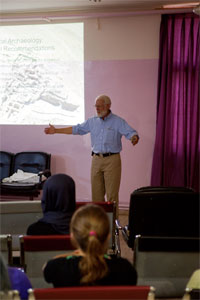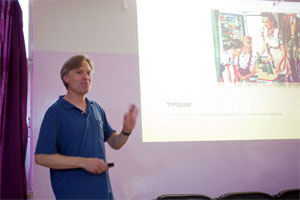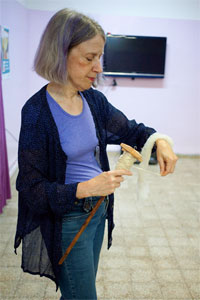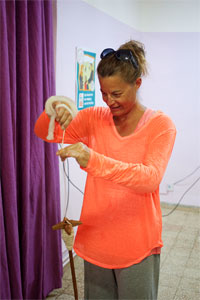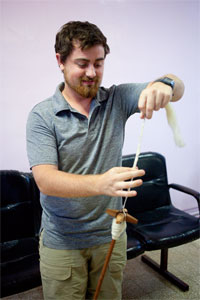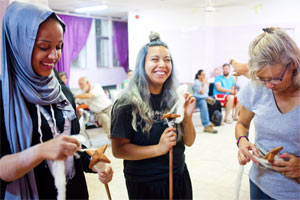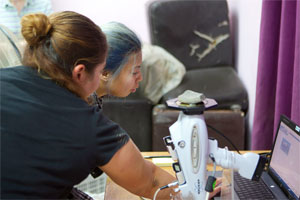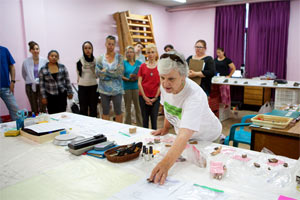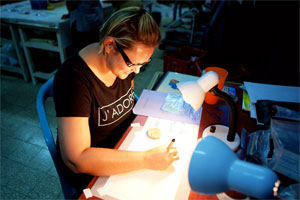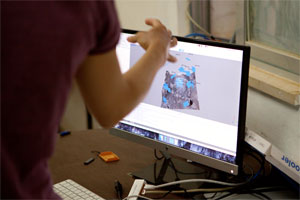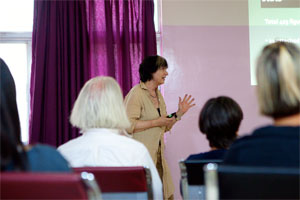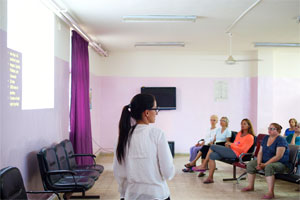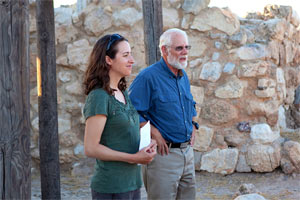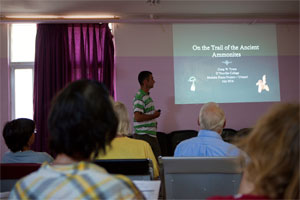Weekly Reports from Jordan
Choose Year: or Choose week
Week 3B – Scholarly Presentations
by Douglas Clark, Photos by Jillian Logee
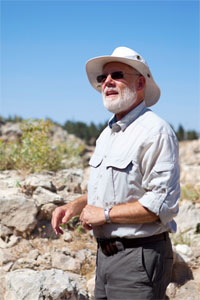 |
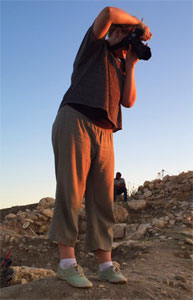 |
Adventures like this summer’s excavations in Jordan require an intellectual framework in which to function responsibly and productively. For this reason, and this reason only, Tuesday and Thursday evenings were invented. Without fail, the team met (a requirement for students earning credit) at 7:00-8:00 pm in the Commons Room or elsewhere for illustrated lectures, hands-on learning station visits, or town hall discussions. Including the overview lecture during Orientation, here are the presentations for the season, enhanced richly by the participation of several specialists:
-
Orientation
-
Wednesday 22 June Orientation to the Madaba Plains Project-`Umayri
- Douglas Clark and Kent Bramlett
-
Wednesday 22 June Orientation to the Madaba Plains Project-`Umayri
-
Lectures
-
Tuesday 28 June Archaeological Periods in Jordan and Surrounding Regions
- Kent Bramlett
-
Thursday 30 June Research Design in the Madaba Plains Project
- Douglas Clark
-
Tuesday 28 June Archaeological Periods in Jordan and Surrounding Regions
-
Learning Station Visits
-
Tuesday 5 July Lithics, Ceramics, and Textiles
- Jillian Logee, Kent Bramlett, and Mary Boyd
-
Thursday 7 July Processing and Documentation
- Jillian Logee, Melissa Hebein, Ruth Kent, Audrey Shaffer, Kristina Reed, and Monique Vincent
-
Tuesday 5 July Lithics, Ceramics, and Textiles
-
Town Hall Discussions
-
Tuesday 12 July Female Figurines at Tall al-`Umayri
- Regine Hunziker-Rodewald
-
Thursday 14 July Jewelry in the Southern Levant
- Josephine Verduci
-
Tuesday 19 July Early Iron I Village of `Umayri (on site)
- Douglas Clark and Monique Vincent
-
Thursday 21 July On the Trail of Ancient Ammonites
- Craig Tyson
-
Tuesday 12 July Female Figurines at Tall al-`Umayri
Brief comments and illustrations:
Orientation to the Madaba Plains Project-`Umayri by Douglas Clark and Kent Bramlett
Orientation covers two full days and serves not only newcomers, but also helps update old hands and reintroduce them and the entire team not only to the archaeology we do, but also to the world and culture of central Jordan and its people. Introductions; explanations of the camp rules; guidelines to live by in Jordan; instructions on all sorts of things, including the non-use of paper in the toilets and one-gallon showers; medical reminders; cultural sensitivities; a quick opening of the digital dig manual, and an illustrated introduction to the project occupied the first day. The second day comes complete with a visit to the site, as well as other MPP sites, then, following lunch, a return to final orientation matters for the season.
Archaeological Periods in Jordan and Surrounding Regions by Kent Bramlett
Beginning in the misty millennia of the prehistoric periods in the ancient Near East, the chronology of the region, especially the southern Levant (Israel, Palestine, Jordan, and southern Syria), provides a temporal framework against which we understand what we excavate. Sites, site features, and artifacts from each of the major periods (like the Bronze or Iron Ages) illustrate lifeways and new technologies which are apparent in the archaeological record with which we work.
Research Design in the Madaba Plains Project by Douglas Clark
From the start, the early days at Tall Hisban in 1968, our work was characterized by several objectives, chief among them the quest to demonstrate the reliability of the biblical account of the battle between Moses and the Israelites on the one hand, and Sihon, King of the Amorites living at Heshbon on the other. Biblical concerns drove this expedition, as they did many in the region up through the 1970s and beyond. Failure to find evidence of any kind of occupation at Hisban during the time of Moses (with either the early or late date of the exodus), forced Siegfried Horn and a cluster of young graduate students to think more broadly about applying newer historical and scientific models to the project. This has led, over nearly 50 years (2018 marks the anniversary which we are beginning to call MPP@50), to some of the most important contributions to Near Eastern archaeology of any project. These we celebrate today, along with continuing work on illustrating the biblical record in the process.
Lithics, Ceramics, and Textiles by Jillian Logee, Kent Bramlett, and Mary Boyd
Learning Station visits provide opportunity for team members to discover and experience, hands-on, some of the methods practiced on most modern excavations. The three subjects covered during this set of presentations and demonstrations encompass major categories of finds we make in the field. Pottery, since its forms are constantly changing over time, provides the chronological backdrop for our work, allowing us to date structures and artifacts found in association with the pottery. Stones make up a good share of our discoveries, with lithics (typically flint flakes) accounting for a surprisingly significant amount of material – typically used as scrapers, knives, sickle blades, awls, drills, and spokeshaves. And evidence for textile use (clay spindle whorls, loom weights, clothing pins, needles, weaving spatulas, etc.) survives long after the fabrics have deteriorated away, helping us recreate ancient practices.
Processing and Documentation by Jillian Logee, Melissa Hebein, Ruth Kent, Audrey Shaffer, Kristina Reed, and Monique Vincent
Given the fact that archaeology is by its very nature a destructive science, archaeologists must, absolutely MUST, take every step possible to document and preserve data retrieved from excavations. This process has become less complicated in some ways, now that we have so very many technologically advanced toys in our hands; it has also become more complicated in some ways, now that we have so very many techno-toys in our hands. Documentation methods demonstrated for this presentation included digital photography, XRF (X-ray Florescence), object and pottery registration processes, artistic renderings, and photogrammetry (the use of multiple photos stitched together digitally to form effective 3D images for more comprehensive research).
Female Figurines at Tall al-`Umayri by Regine Hunziker-Rodewald
A specialist in human figurines from the ancient Near East, Regine Hunziker-Rodewald has been studying female figurines from `Umayri and other sites in Jordan for several years. As simple as it may seem to distinguish female figurines from those of males, this is not always the case, given ancient artistic conventions and the poor state of preservation of some of our figurines. Her work explores not only the basic data of these ancient artifacts, but attempts to understand function and meaning.
Jewelry in the Southern Levant by Josephine Verduci
Jewelry and adornment in the ancient world has always fascinated moderns concerned with similar expressions of beauty and significance. Jo Verduci, who recently completed her PhD focused on ancient jewelry (or “jewellrey,” as she prefers from her Aussie homeland!), explores not only various types of adornment, describing rings, earrings, bracelets, bangles, clothes pins, beads, pendants, shells, etc., but also attempts to assign meaning, significance, and function to these precious items. Her expertise helped us make sense of a number of finds this summer.
Early Iron I Village of `Umayri (on site) by Douglas Clark and Monique Vincent
From time immemorial, Doug Clark has hauled everyone back out to the tell one evening each season so that we can all sit together in the “four-room” house to ponder its conception, construction, occupation, and demise. Putting all of our human senses to work, we imagine and attempt to experience the sights, sounds, feel, and smells (especially smells) associated with living in a pre-industrial household along with agricultural supplies and farm-animals on the main (ground) floor. Now that Monique Vincent has completed her PhD on this very household and its neighbors, she joined Doug, pressing our discussion beyond the house itself to the neighborhood and its social and economic dynamics.
On the Trail of Ancient Ammonites by Craig Tyson
Our final lecture/town hall meeting of the season came courtesy of Craig Tyson. His recent PhD dissertation on the ancient Ammonites was published last year, and represents a major contribution to the history and culture of the tribal groups/state government known as the sons of Ammon/Ammonites in the territory where we excavate, especially during the period of the 8th-6th centuries BC. His synthesis brings together textual (including Bible) and artifactual evidence illustrating political, economic, and religious aspects of the Ammonites. We have asked Craig to join us as a co-PI (co-primary investigator) in a three-year project funded by Versacare Foundation: On the Trail of Ancient Ammonites and Moabites.
